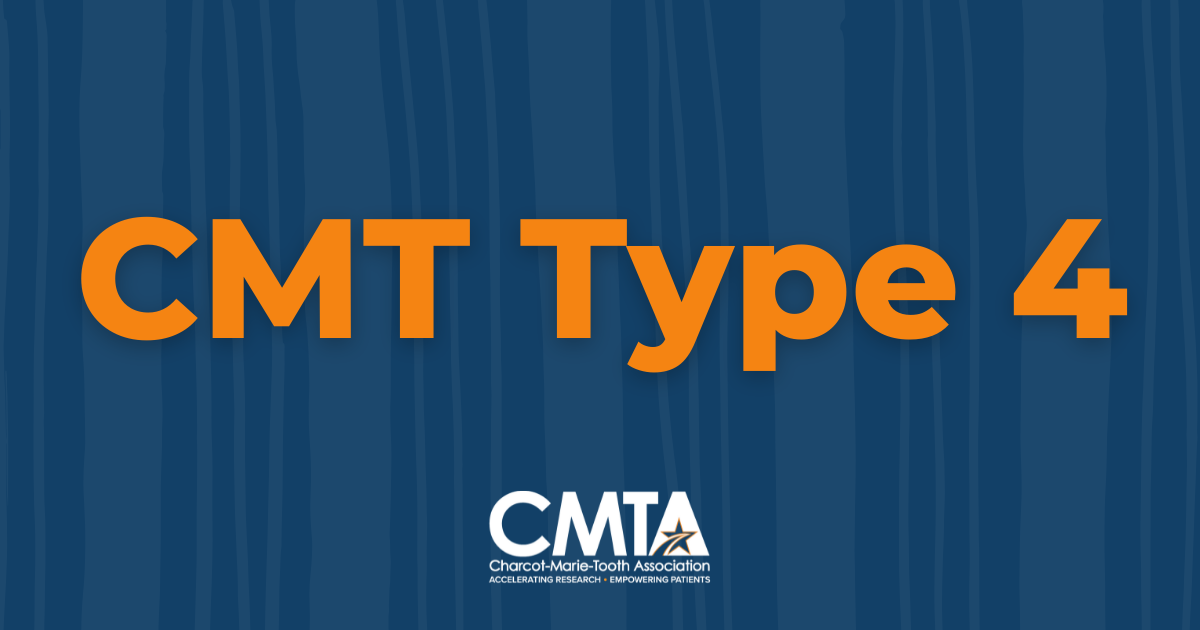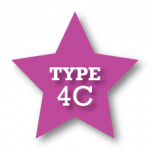Charcot-Marie-Tooth disease Type 4 (CMT4)

What is CMT Type 4?
All Type 4 instances of CMT are inherited in an autosomal recessive pattern (see inheritance) and are rare in the United States (~5% of cases). Type 4 is also typically demyelinating. They have various presentations, with some being mild and some severe. These disorders may also have symptoms in other areas of the body, such as cataracts and deafness.What causes CMT4
CMT4 is caused by a variety of gene mutations inherited in an autosomal recessive pattern. The person with CMT4 would have two copies of the affected gene to develop symptoms. These genes are not located on the chromosomes associated with determining biological sex. Both parents of the person with CMT4 are “carriers” of the affected gene. The parent carrier has one copy of affected gene with recessive inheritance and will not exhibit symptoms of CMT4.
Mutated genes related to Type 4 include:
- CMT4A – Ganglioside-induced differentiation-associated protein 1 (GDAP1)
- CMT4B1 – Myotubularin related protein 2 (MTMR2)
- CMT4B2 – SET binding factor 2 (SBF2/MTMR13)
- CMT4B3 – SET binding factor 1 (SBF1/MTMR5)
- CMT4C – SH3 domain and tetratricopeptide repeat-containing protein 2 (SH3TC2/KIAA1985)
- CMT4D – N-myc downstream regulated 1 (NDRG1)
- CMT4E or CHN-1 – Early growth response 2 (EGR2/Krox20)
- CMT4F – Periaxin (PRX)
- CMT4G or HMSN-Russe Type (HMSNR) – Hexokinase 1 (HK1)
- CMT4H – FYVE, RhoGEF, and PH domain-containing protein 4 (FGD4)
- CMT4J – Polyphosphoinositide phosphatase (FIG4)
- CMT4K – Surfeit locus protein 1 (SURF1)
What are the Symptoms of CMT4
The symptoms of people with CMT4 usually progress faster than those of people with autosomal dominant CMT types. Signs and symptoms include a broad spectrum, but MAY include:
- pes cavus (high arch) and hammertoes
- pes equino-varus (claw-like hands)
- spinal abnormalities
- cataracts
- deafness
- High or flat arches
- Respiratory problems due to progression of disease/involvement of breathing muscles and diaphragm weakness
- Bony or joint abnormalities
- CNS involvement (issues with cognition or other brain functions)
When do symptoms of CMT4 start?
The age of onset typically occurs during early infancy (before the age of 3), but can also begin later in life.
What are the Type 4 Subtypes?
This section is being updated. Please refer to the above section for the full list of CMT Type 4 subtypes currently known and their associated gene mutations.
-
-
Type 4A
 CMT4A is caused by mutations in the GDAP1 gene. This gene has been found to cause CMT4A (recessive, demyelinating, axonal or intermediate CMT – about 75% of people with GDAP1 mutations), and CMT2K (dominant axonal CMT – about 25% of people with GDAP1 mutations). People with CMT4A have onset of symptoms in the first two decades of life, most before age 10 years. Symptoms affect both lower and upper limbs, including muscle wasting and contractures, and delayed milestones such as sitting and walking. Most people need walking assistance, such as AFOs, canes or walkers, by 30 years of age, and about 75% use a wheelchair after 30 years. As disease progresses, a hoarse voice can develop and vocal cord paresis have been reported. Life expectancy and intelligence are not affected.
CMT4A is caused by mutations in the GDAP1 gene. This gene has been found to cause CMT4A (recessive, demyelinating, axonal or intermediate CMT – about 75% of people with GDAP1 mutations), and CMT2K (dominant axonal CMT – about 25% of people with GDAP1 mutations). People with CMT4A have onset of symptoms in the first two decades of life, most before age 10 years. Symptoms affect both lower and upper limbs, including muscle wasting and contractures, and delayed milestones such as sitting and walking. Most people need walking assistance, such as AFOs, canes or walkers, by 30 years of age, and about 75% use a wheelchair after 30 years. As disease progresses, a hoarse voice can develop and vocal cord paresis have been reported. Life expectancy and intelligence are not affected.
-
-
-
Type 4B
 The genetic location for the defect causing CMT4B is on chromosome 11 and presents with focally folded myelin sheaths in nerve biopsies. Affected patients become symptomatic early in life, with an average age of onset at 34 months. Unlike most types of CMT, both proximal and distal weakness is common.
The genetic location for the defect causing CMT4B is on chromosome 11 and presents with focally folded myelin sheaths in nerve biopsies. Affected patients become symptomatic early in life, with an average age of onset at 34 months. Unlike most types of CMT, both proximal and distal weakness is common.
-
-
-
Type 4C
 CMT4C is caused by mutations in SH3TC2 and has a wide variability of severity. This type of CMT involves childhood onset of sensory and motor neuropathy in the lower limbs and high arched or flat feet. Patients often have mild difficulty with walking, and some may need a wheelchair. Scoliosis is almost always present, usually onset in the first two decades. The onset of neuropathy symptoms range, some beginning in the first decade of life, and others do not onset until adulthood. Lower limb and upper limb weakness is common, beginning towards the hands and feet and sometimes extending above the elbows and knees. Hearing loss, vocal cord involvement, and facial paresis have been reported. This is a demyelinating form of CMT, with conductions usually ranging between 16 and 36 m/s in the arms.
CMT4C is caused by mutations in SH3TC2 and has a wide variability of severity. This type of CMT involves childhood onset of sensory and motor neuropathy in the lower limbs and high arched or flat feet. Patients often have mild difficulty with walking, and some may need a wheelchair. Scoliosis is almost always present, usually onset in the first two decades. The onset of neuropathy symptoms range, some beginning in the first decade of life, and others do not onset until adulthood. Lower limb and upper limb weakness is common, beginning towards the hands and feet and sometimes extending above the elbows and knees. Hearing loss, vocal cord involvement, and facial paresis have been reported. This is a demyelinating form of CMT, with conductions usually ranging between 16 and 36 m/s in the arms.
-
-
-
Type 4D
 CMT4D was first described as a separate disorder with linkage to Chromosome 8 in a Gypsy population with autosomal recessive inheritance. The clinical features included distal weakness, muscle wasting and sensory loss, foot and hand deformities and loss of deep tendon reflexes. Deafness is always found in these patients and occurs by the third decade. Nerve conduction is severely reduced in younger patients and completely unattainable after age 15.
CMT4D was first described as a separate disorder with linkage to Chromosome 8 in a Gypsy population with autosomal recessive inheritance. The clinical features included distal weakness, muscle wasting and sensory loss, foot and hand deformities and loss of deep tendon reflexes. Deafness is always found in these patients and occurs by the third decade. Nerve conduction is severely reduced in younger patients and completely unattainable after age 15.
-
-
-
Type 4F
 CMT4F is a severe form of recessive CMT that has been defined in a large Lebanese family with mutations in the PRX gene on Chromosome 19. Nerve conduction studies are markedly slow and onion bulb formations are observed in nerve biopsies.
CMT4F is a severe form of recessive CMT that has been defined in a large Lebanese family with mutations in the PRX gene on Chromosome 19. Nerve conduction studies are markedly slow and onion bulb formations are observed in nerve biopsies.
-
-
-
Type 4J
 CMT4J is caused by mutations in a gene called FIG4, which is located on chromosome 6. This is a rare form of CMT that wasn’t identified until 2007. Because not many people have this form, our understanding of how it progresses is limited. Symptoms and age of onset are variable; some people have a classic presentation, while others have a slowly progressive neuropathy with more severe changes later in adulthood. CMT4J causes intermediate to slow nerve conductions due to changes in the myelin, the sheath around the nerve “wire.” It is an autosomal recessive form of CMT (CMT4), which means an individual has to have a mutation in each copy of the gene (one from each parent) in order to have symptoms. Not all changes in FIG4 cause disease, however. If one of an individual’s two mutations is benign, he or she would not have CMT4J.
CMT4J is caused by mutations in a gene called FIG4, which is located on chromosome 6. This is a rare form of CMT that wasn’t identified until 2007. Because not many people have this form, our understanding of how it progresses is limited. Symptoms and age of onset are variable; some people have a classic presentation, while others have a slowly progressive neuropathy with more severe changes later in adulthood. CMT4J causes intermediate to slow nerve conductions due to changes in the myelin, the sheath around the nerve “wire.” It is an autosomal recessive form of CMT (CMT4), which means an individual has to have a mutation in each copy of the gene (one from each parent) in order to have symptoms. Not all changes in FIG4 cause disease, however. If one of an individual’s two mutations is benign, he or she would not have CMT4J.
-






 CMT4A is caused by mutations in the GDAP1 gene. This gene has been found to cause CMT4A (recessive, demyelinating, axonal or intermediate CMT – about 75% of people with GDAP1 mutations), and CMT2K (dominant axonal CMT – about 25% of people with GDAP1 mutations). People with CMT4A have onset of symptoms in the first two decades of life, most before age 10 years. Symptoms affect both lower and upper limbs, including muscle wasting and contractures, and delayed milestones such as sitting and walking. Most people need walking assistance, such as AFOs, canes or walkers, by 30 years of age, and about 75% use a wheelchair after 30 years. As disease progresses, a hoarse voice can develop and vocal cord paresis have been reported. Life expectancy and intelligence are not affected.
CMT4A is caused by mutations in the GDAP1 gene. This gene has been found to cause CMT4A (recessive, demyelinating, axonal or intermediate CMT – about 75% of people with GDAP1 mutations), and CMT2K (dominant axonal CMT – about 25% of people with GDAP1 mutations). People with CMT4A have onset of symptoms in the first two decades of life, most before age 10 years. Symptoms affect both lower and upper limbs, including muscle wasting and contractures, and delayed milestones such as sitting and walking. Most people need walking assistance, such as AFOs, canes or walkers, by 30 years of age, and about 75% use a wheelchair after 30 years. As disease progresses, a hoarse voice can develop and vocal cord paresis have been reported. Life expectancy and intelligence are not affected.
 The genetic location for the defect causing CMT4B is on chromosome 11 and presents with focally folded myelin sheaths in nerve biopsies. Affected patients become symptomatic early in life, with an average age of onset at 34 months. Unlike most types of CMT, both proximal and distal weakness is common.
The genetic location for the defect causing CMT4B is on chromosome 11 and presents with focally folded myelin sheaths in nerve biopsies. Affected patients become symptomatic early in life, with an average age of onset at 34 months. Unlike most types of CMT, both proximal and distal weakness is common.
 CMT4C is caused by mutations in SH3TC2 and has a wide variability of severity. This type of CMT involves childhood onset of sensory and motor neuropathy in the lower limbs and high arched or flat feet. Patients often have mild difficulty with walking, and some may need a wheelchair. Scoliosis is almost always present, usually onset in the first two decades. The onset of neuropathy symptoms range, some beginning in the first decade of life, and others do not onset until adulthood. Lower limb and upper limb weakness is common, beginning towards the hands and feet and sometimes extending above the elbows and knees. Hearing loss, vocal cord involvement, and facial paresis have been reported. This is a demyelinating form of CMT, with conductions usually ranging between 16 and 36 m/s in the arms.
CMT4C is caused by mutations in SH3TC2 and has a wide variability of severity. This type of CMT involves childhood onset of sensory and motor neuropathy in the lower limbs and high arched or flat feet. Patients often have mild difficulty with walking, and some may need a wheelchair. Scoliosis is almost always present, usually onset in the first two decades. The onset of neuropathy symptoms range, some beginning in the first decade of life, and others do not onset until adulthood. Lower limb and upper limb weakness is common, beginning towards the hands and feet and sometimes extending above the elbows and knees. Hearing loss, vocal cord involvement, and facial paresis have been reported. This is a demyelinating form of CMT, with conductions usually ranging between 16 and 36 m/s in the arms.
 CMT4D was first described as a separate disorder with linkage to Chromosome 8 in a Gypsy population with autosomal recessive inheritance. The clinical features included distal weakness, muscle wasting and sensory loss, foot and hand deformities and loss of deep tendon reflexes. Deafness is always found in these patients and occurs by the third decade. Nerve conduction is severely reduced in younger patients and completely unattainable after age 15.
CMT4D was first described as a separate disorder with linkage to Chromosome 8 in a Gypsy population with autosomal recessive inheritance. The clinical features included distal weakness, muscle wasting and sensory loss, foot and hand deformities and loss of deep tendon reflexes. Deafness is always found in these patients and occurs by the third decade. Nerve conduction is severely reduced in younger patients and completely unattainable after age 15.
 CMT4F is a severe form of recessive CMT that has been defined in a large Lebanese family with mutations in the PRX gene on Chromosome 19. Nerve conduction studies are markedly slow and onion bulb formations are observed in nerve biopsies.
CMT4F is a severe form of recessive CMT that has been defined in a large Lebanese family with mutations in the PRX gene on Chromosome 19. Nerve conduction studies are markedly slow and onion bulb formations are observed in nerve biopsies.
 CMT4J is caused by mutations in a gene called FIG4, which is located on chromosome 6. This is a rare form of CMT that wasn’t identified until 2007. Because not many people have this form, our understanding of how it progresses is limited. Symptoms and age of onset are variable; some people have a classic presentation, while others have a slowly progressive neuropathy with more severe changes later in adulthood. CMT4J causes intermediate to slow nerve conductions due to changes in the myelin, the sheath around the nerve “wire.” It is an autosomal recessive form of CMT (CMT4), which means an individual has to have a mutation in each copy of the gene (one from each parent) in order to have symptoms. Not all changes in FIG4 cause disease, however. If one of an individual’s two mutations is benign, he or she would not have CMT4J.
CMT4J is caused by mutations in a gene called FIG4, which is located on chromosome 6. This is a rare form of CMT that wasn’t identified until 2007. Because not many people have this form, our understanding of how it progresses is limited. Symptoms and age of onset are variable; some people have a classic presentation, while others have a slowly progressive neuropathy with more severe changes later in adulthood. CMT4J causes intermediate to slow nerve conductions due to changes in the myelin, the sheath around the nerve “wire.” It is an autosomal recessive form of CMT (CMT4), which means an individual has to have a mutation in each copy of the gene (one from each parent) in order to have symptoms. Not all changes in FIG4 cause disease, however. If one of an individual’s two mutations is benign, he or she would not have CMT4J.